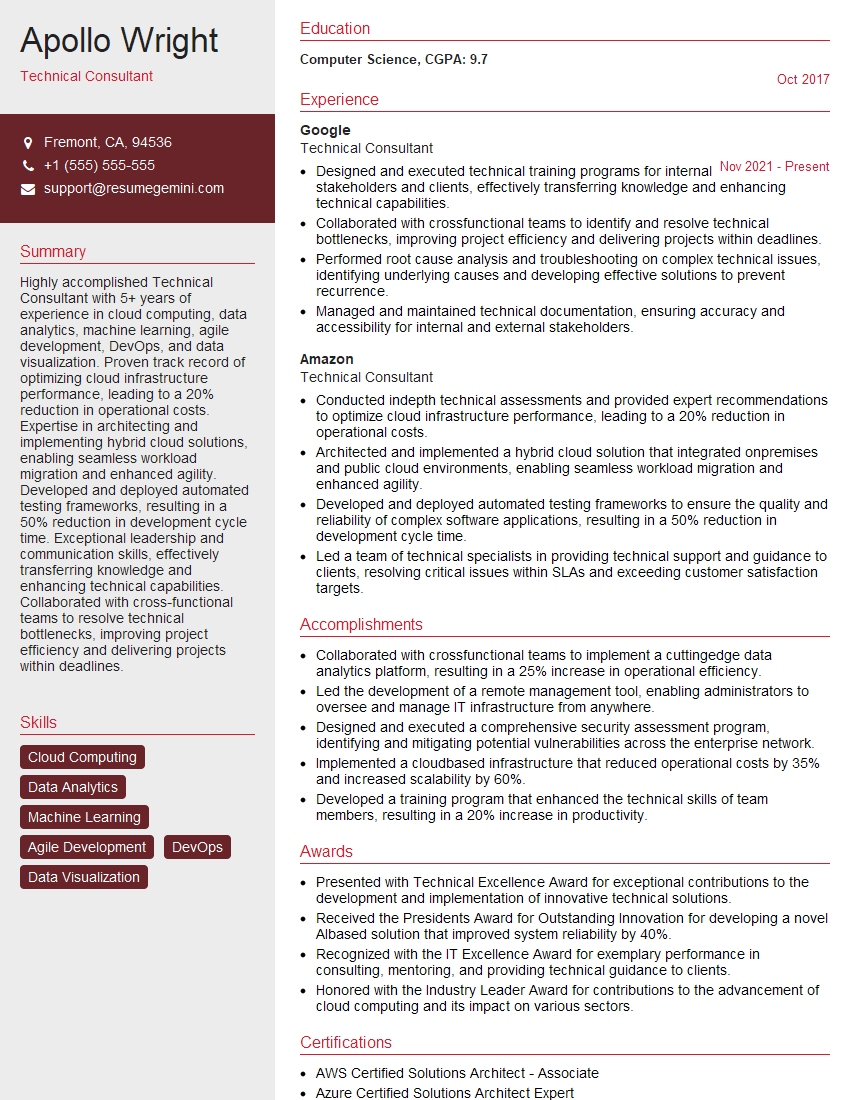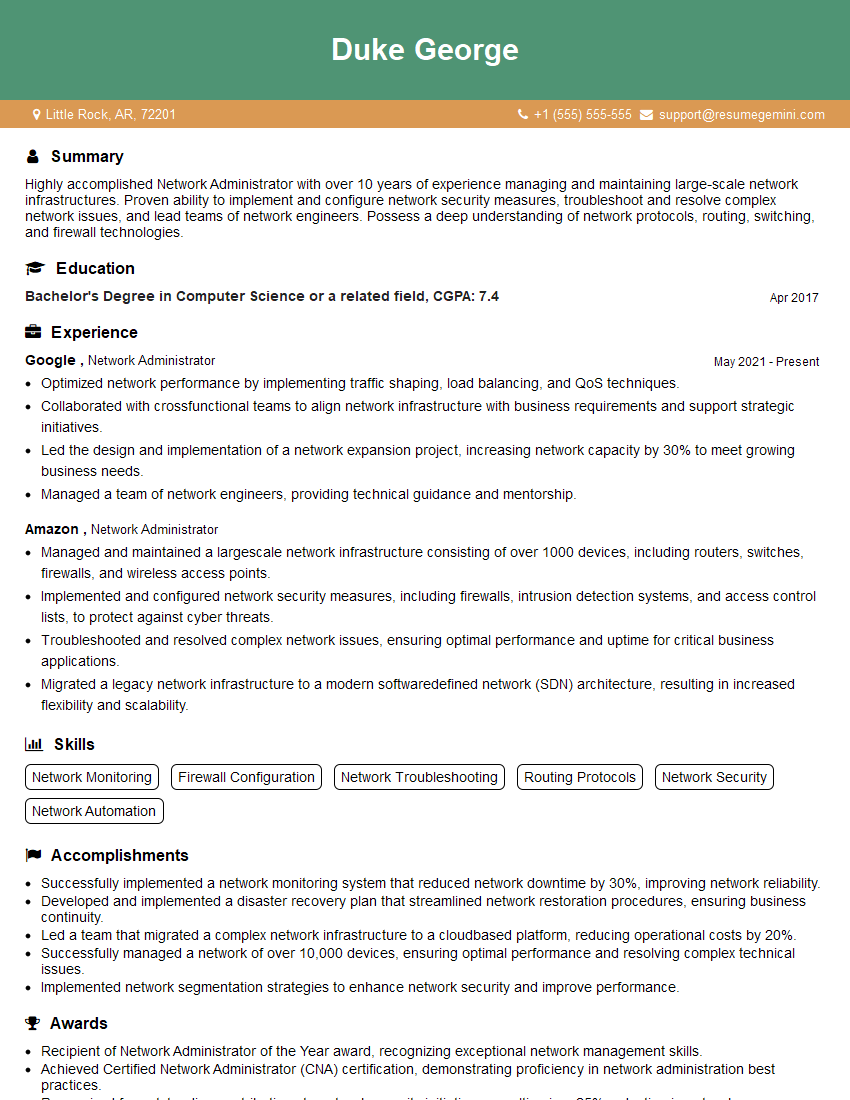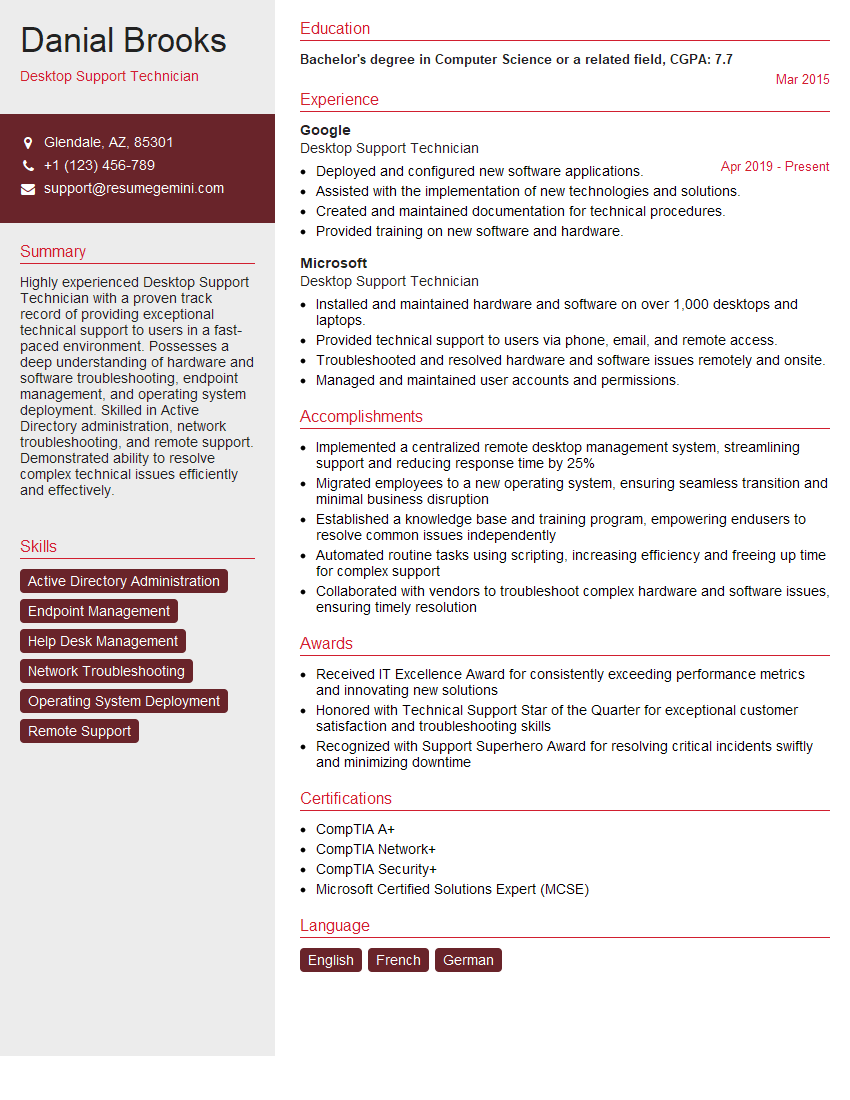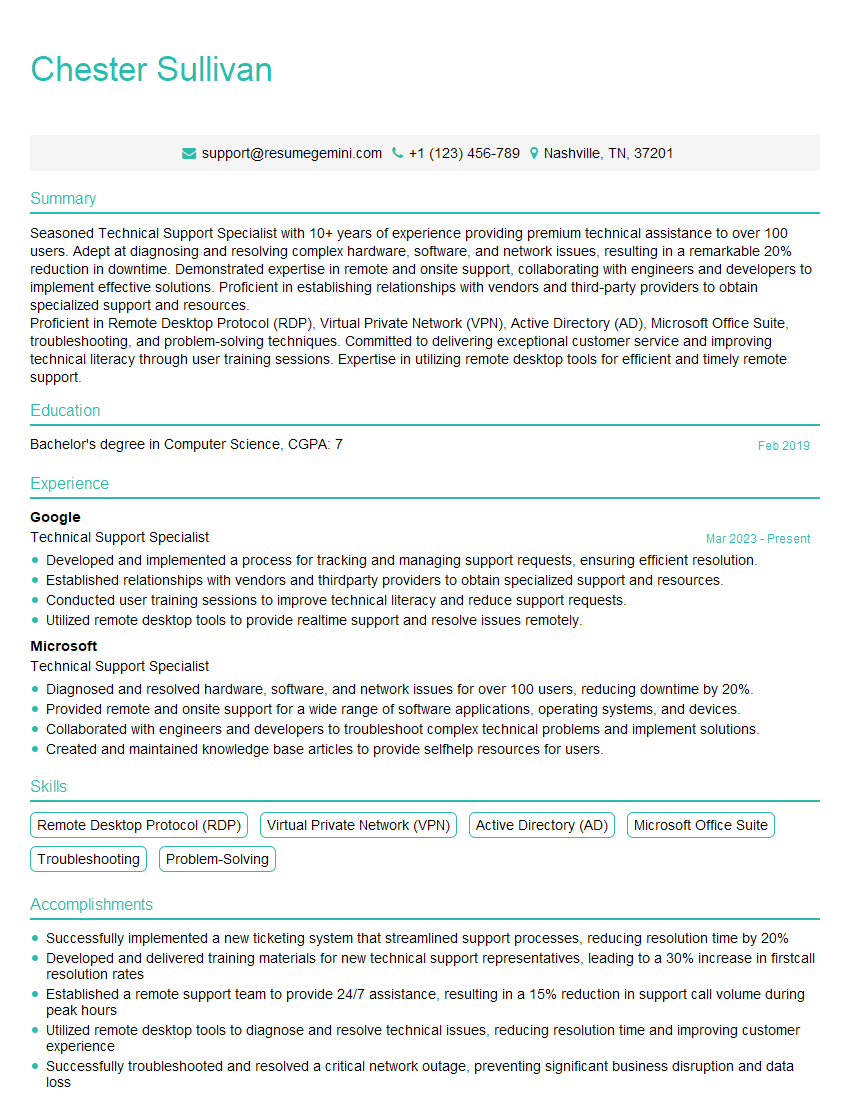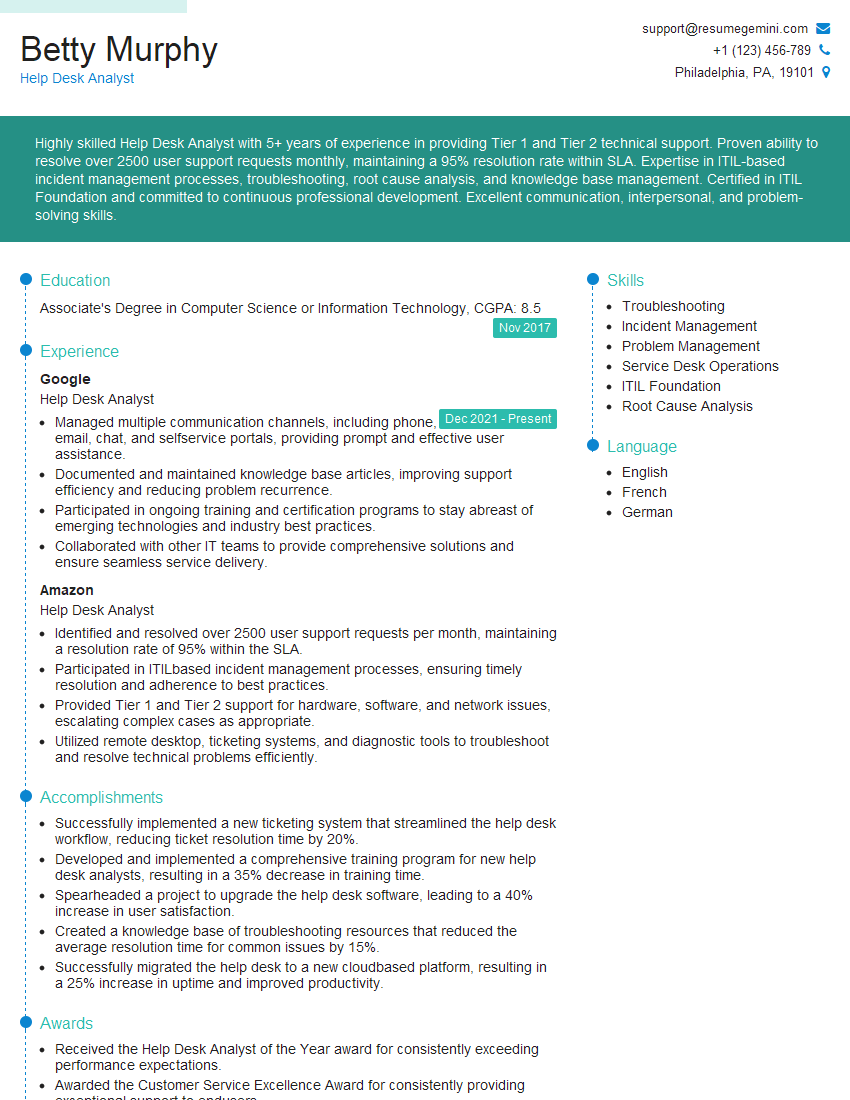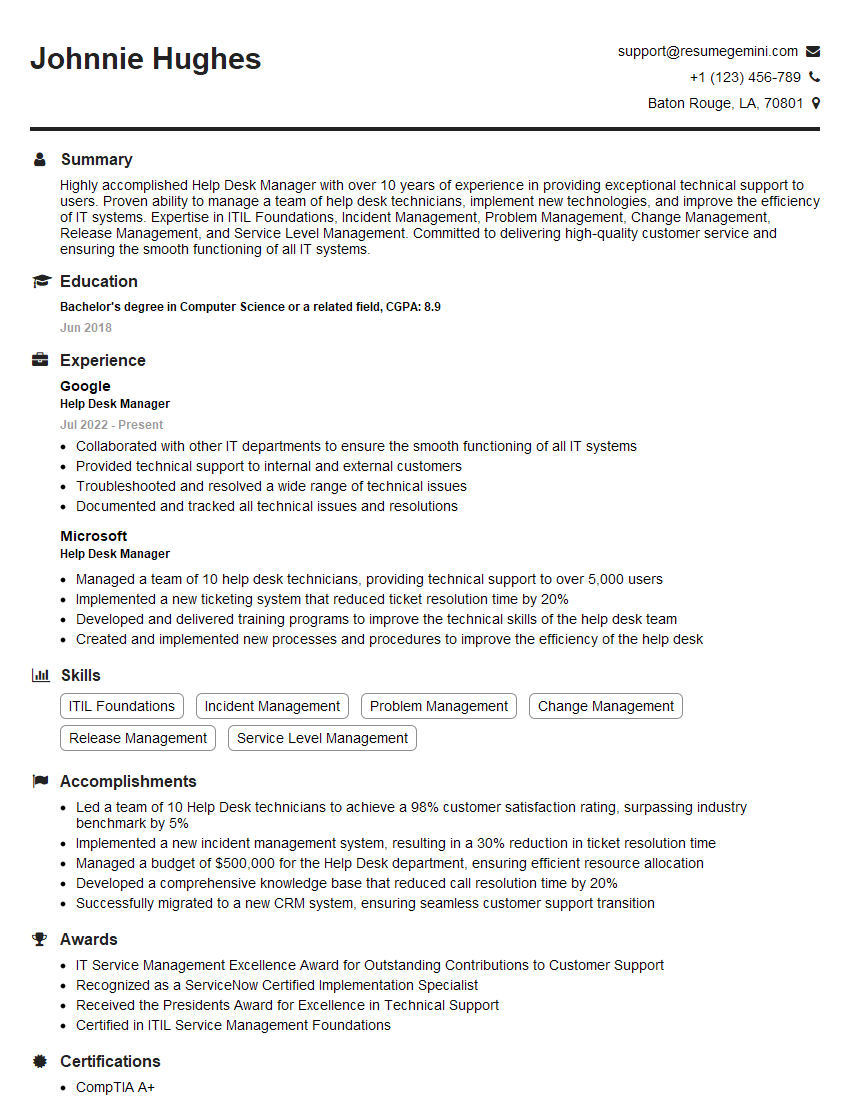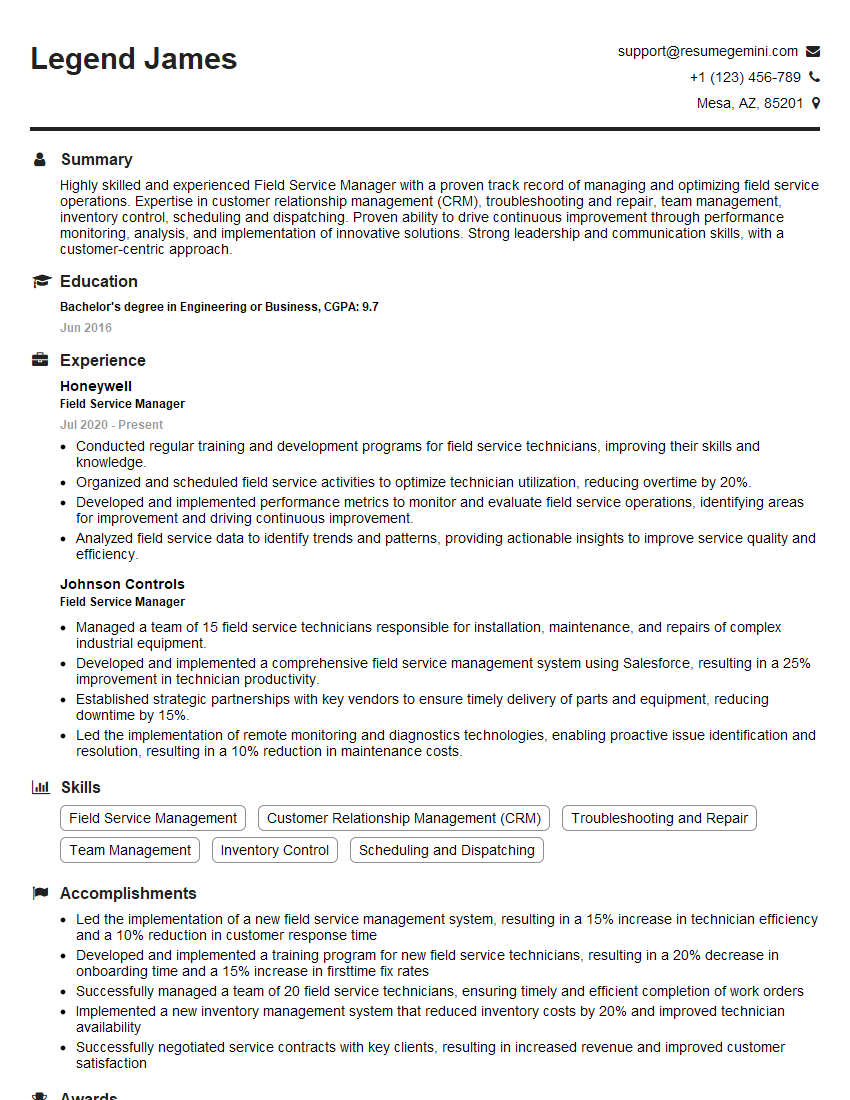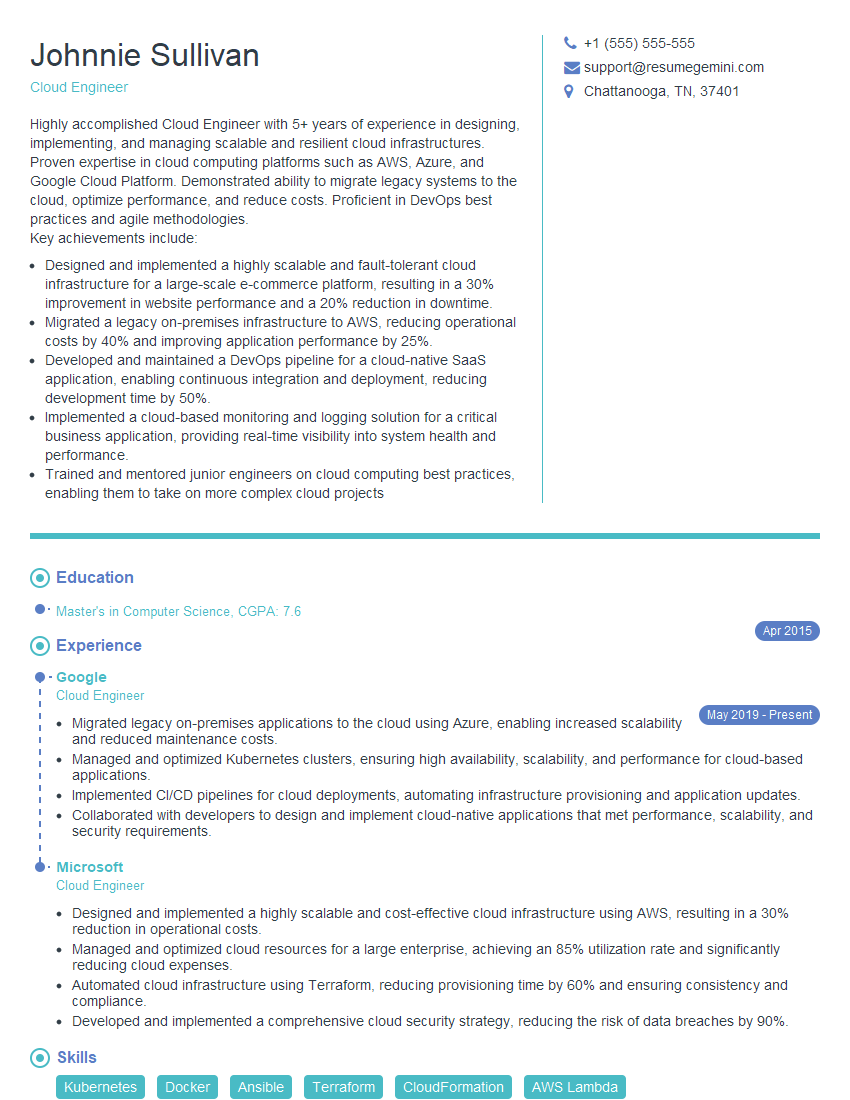Unlock your full potential by mastering the most common Troubleshooting and fault finding interview questions. This blog offers a deep dive into the critical topics, ensuring you’re not only prepared to answer but to excel. With these insights, you’ll approach your interview with clarity and confidence.
Questions Asked in Troubleshooting and fault finding Interview
Q 1. Describe your troubleshooting methodology.
My troubleshooting methodology follows a systematic approach, often described as a cyclical process. It begins with identification of the problem: clearly defining the symptoms, impact, and affected systems. Next comes investigation: gathering information through questioning users, reviewing logs, checking system status, and performing diagnostics. This stage often involves replicating the issue if possible. The third step is hypothesis generation: forming educated guesses about the root cause based on the gathered information. Then comes testing: verifying the hypotheses through targeted actions and observations. If a hypothesis is confirmed, the solution is implemented and verified. If not, the cycle continues with new hypotheses. Finally, documentation of the entire process is crucial for future reference and learning. I always aim to address the root cause, not just the symptoms.
Think of it like detective work. You wouldn’t arrest someone without sufficient evidence! Similarly, fixing a problem requires systematic investigation before implementing a solution.
Q 2. Explain the difference between reactive and proactive troubleshooting.
Reactive troubleshooting addresses problems *after* they occur. It’s like putting out fires – you react to the immediate crisis. For example, a server crashes, and you jump in to restart it and restore service. Proactive troubleshooting, on the other hand, aims to prevent problems *before* they happen. This involves tasks such as preventative maintenance, capacity planning, security audits, and performance monitoring. For instance, regularly backing up data prevents data loss from a hard drive failure. While reactive troubleshooting is essential, proactive measures significantly reduce the frequency and severity of incidents, saving time and resources in the long run.
Imagine a car: reactive troubleshooting is like fixing a flat tire after it happens. Proactive troubleshooting is like regularly checking tire pressure and rotating tires to prevent flats.
Q 3. How do you prioritize troubleshooting tasks in a high-pressure environment?
Prioritizing in high-pressure situations requires a structured approach. I use a combination of factors to determine urgency and impact. Impact considers the number of users affected, the criticality of the affected system, and the potential financial or reputational damage. Urgency assesses how quickly the issue needs resolution – is it causing a complete outage or a minor inconvenience? I also consider the effort required to resolve the issue. A simple fix that resolves a major outage takes priority over a complex problem with minimal immediate impact. I use a matrix or a prioritized list to visually manage tasks, frequently re-evaluating priorities as new information comes in. Open communication with stakeholders is critical to ensure everyone understands the rationale behind the prioritization.
Think of it as triage in a hospital: the most critically injured patients receive immediate attention, even if it takes longer than less critical cases.
Q 4. What tools and techniques do you use for remote troubleshooting?
Remote troubleshooting relies heavily on a suite of tools and techniques. I commonly use remote desktop software (like TeamViewer or AnyDesk) to access and control user machines. SSH (Secure Shell) provides command-line access to servers for troubleshooting network and system issues. Monitoring tools like Nagios or Zabbix provide real-time system health data, alerting me to potential problems before users report them. Effective communication is crucial; I use tools like Slack or Microsoft Teams for quick updates and collaboration. I also rely on log analysis to trace the history of events leading to the problem. Finally, I often employ collaboration tools that allow me to share screens, files, and chat with colleagues during complex troubleshooting.
Remote tools effectively bridge geographical distances, enabling fast resolution of IT issues without needing physical presence.
Q 5. How do you document your troubleshooting process?
Documentation is paramount. I maintain detailed records of each troubleshooting incident, including the date, time, affected systems, symptoms reported, steps taken, results obtained, and the final resolution. This is usually done in a ticket management system (like Jira or ServiceNow) that provides version history and easy searching. I clearly document all troubleshooting steps, successful or unsuccessful, including error messages, command outputs, and configuration changes. This information is vital for future troubleshooting, knowledge sharing, and performance analysis. Good documentation often includes screenshots and screen recordings, particularly for visually-oriented problems.
Thorough documentation acts as a repository of knowledge for both future reference and team learning.
Q 6. How do you handle situations where you’re unable to resolve an issue?
When I’m unable to resolve an issue independently, I escalate appropriately. This involves clearly communicating the problem, my troubleshooting attempts, and the remaining roadblocks to my supervisor or a more senior engineer. I provide all relevant documentation and logs to support my explanation. I might also engage with external support teams from vendors or service providers, depending on the nature of the problem. Open and transparent communication is key; proactively updating stakeholders on progress (or lack thereof) keeps everyone informed and fosters collaboration. The goal is to find a solution effectively and ensure minimal disruption.
Knowing when to seek help is a sign of strength, not weakness.
Q 7. Describe a time you had to troubleshoot a complex technical problem.
I once encountered a complex network performance issue affecting a major client’s e-commerce platform. Initially, the symptoms were intermittent slowdowns, resulting in lost sales and frustrated customers. My investigation involved analyzing network logs, inspecting server performance metrics, and running network trace routes. After ruling out obvious issues like server overload or network congestion, I discovered that a recently deployed security update had introduced a conflict with a third-party network monitoring tool. This conflict caused periodic packet drops, significantly impacting performance. I coordinated with the security team to roll back the update and work with the vendor to resolve the compatibility issue. The problem was resolved, and detailed documentation was created to prevent similar incidents in the future. This experience highlighted the importance of thorough investigation and cross-team collaboration in resolving intricate technical issues.
Q 8. Explain your experience with using diagnostic tools.
My experience with diagnostic tools spans a wide range, from basic command-line utilities to sophisticated network analyzers and specialized software. For instance, I routinely use tools like ping, traceroute, and nslookup for initial network troubleshooting. These tools provide quick insights into network connectivity and help isolate problems. For deeper dives into network performance, I leverage Wireshark for packet capture and analysis, identifying bottlenecks or protocol errors. In the realm of server diagnostics, I’m proficient with tools like top (Linux) and Task Manager (Windows) to monitor resource utilization (CPU, memory, disk I/O), helping identify performance bottlenecks or resource exhaustion. For application-specific debugging, I utilize integrated development environment (IDE) debuggers, allowing me to step through code, inspect variables, and identify the root cause of software malfunctions. I also have experience with specialized hardware diagnostic tools, such as those used for testing RAM or hard drive health. Choosing the right tool depends heavily on the nature of the problem; a systematic approach ensures I select the most effective diagnostic method quickly.
Q 9. How do you effectively communicate technical information to non-technical users?
Effectively communicating technical information to non-technical users requires empathy and a structured approach. I avoid technical jargon as much as possible, opting for plain language and relatable analogies. For example, explaining network latency using the analogy of a congested highway instead of packet loss is far more effective. I always start by understanding the user’s level of technical knowledge and tailor my explanation accordingly. Visual aids like diagrams or flowcharts can significantly improve comprehension. I break down complex issues into smaller, easily digestible chunks, prioritizing the essential information. Active listening and asking clarifying questions ensure I’m addressing the user’s specific concerns and needs. I also focus on providing actionable steps the user can take, even if it’s simply reporting the problem with clear details. The goal is to empower the user to understand the problem and participate in the solution, building trust and confidence in the process. For instance, when a user complains of slow internet, I wouldn’t start with TCP/IP packet headers but would instead ask about recent changes to their devices or network and then provide simple steps like restarting their router.
Q 10. What are some common causes of network connectivity issues?
Network connectivity issues stem from a variety of causes, often stemming from a combination of factors. Common culprits include:
- Physical cable problems: Loose, damaged, or improperly connected cables are frequent offenders.
- Router or modem issues: These can range from simple configuration problems to hardware failures.
- Network configuration errors: Incorrect IP addresses, subnet masks, or DNS settings can prevent devices from communicating.
- Firewall or security software interference: These can block legitimate network traffic.
- Wireless interference: Overlapping Wi-Fi networks, physical obstructions, or signal degradation can cause connectivity problems.
- DNS server issues: Problems resolving domain names can prevent access to websites and online services.
- ISP outages: Problems with the internet service provider itself can impact connectivity across all devices.
- Driver issues: Outdated or corrupted network drivers on the device can disrupt connectivity.
Troubleshooting often involves a methodical process of elimination, using diagnostic tools mentioned earlier to isolate the source of the problem.
Q 11. How do you identify and isolate hardware failures?
Identifying and isolating hardware failures requires a systematic approach combining observation, diagnostic tools, and testing. The process typically starts with observing the system’s behavior – unusual sounds, error messages, or performance degradation. Next, I employ diagnostic tools like the system’s BIOS or UEFI (for boot issues), specialized hardware diagnostic software (for disk drives or RAM), or even physical inspection (looking for visible damage). For example, a hard drive clicking sound strongly suggests imminent failure. I’ll often use tools like smartctl (Linux) or the Windows equivalent to check drive health statistics. If a component is suspected, I’ll isolate it by replacing it with a known-good component and testing the system. Detailed logging and documentation throughout the process are essential to record the sequence of events and the results of diagnostic steps. This aids in accurate root cause analysis and helps in preventing future occurrences.
Q 12. Explain your experience with software debugging.
My experience with software debugging is extensive, encompassing various methodologies and tools. I’m proficient in using IDE debuggers (like those in Visual Studio, Eclipse, or Xcode), stepping through code line by line, setting breakpoints, inspecting variables, and evaluating expressions. This allows me to pinpoint the exact location and cause of errors, such as segmentation faults, null pointer exceptions, or logic errors. I utilize logging extensively, embedding logging statements throughout my code to track program execution flow and identify unexpected behavior. For more complex problems, I use techniques like binary search to narrow down the problematic code sections and employ profiling tools to analyze code performance and identify bottlenecks. Furthermore, I understand the importance of using version control systems (like Git) to manage code changes, facilitating easier rollback to previous stable versions and easier collaboration with colleagues. Debugging is not just about fixing the error but understanding why it occurred to prevent similar issues in the future.
Q 13. How do you handle escalated support tickets?
Handling escalated support tickets requires a calm, methodical approach, focused on quick resolution and customer satisfaction. The first step is a thorough review of the existing documentation and any troubleshooting steps already taken. I then establish clear communication with the user, actively listening to understand their issue and gathering any additional information needed. I leverage my experience to replicate the problem if possible or engage with other specialists to help solve the issue if outside my immediate area of expertise. I keep the user updated throughout the process, providing regular progress reports, even if there is no immediate solution. For particularly complex escalations, I might set up a conference call to involve multiple team members. Once a solution is found, I document it meticulously, both for the ticket closure and as a knowledge base for future reference. Successful escalation management relies on effective communication, problem-solving skills, and a dedication to finding a resolution, even if it requires collaboration beyond the individual.
Q 14. What is your experience with incident management systems?
My experience with incident management systems encompasses various platforms, including Jira, ServiceNow, and others. I am familiar with the complete lifecycle of an incident: logging, prioritizing, assigning, investigating, resolving, and closing. I understand the importance of accurate documentation, providing detailed descriptions of the incident, affected services, and resolution steps. I use these systems to monitor incident trends, identify recurring problems, and track overall system performance. My proficiency includes setting up alerts and notifications for critical incidents, ensuring timely responses and minimizing service disruptions. Moreover, I actively participate in post-incident reviews, collaborating with other teams to analyze root causes, implement preventative measures, and improve the overall incident management process. This collaborative approach ensures continuous improvement and more robust system resilience.
Q 15. How familiar are you with different operating systems (e.g., Windows, Linux, macOS)?
My experience spans across various operating systems, including Windows (all versions from XP to 11, including Server editions), various Linux distributions (like Red Hat, CentOS, Ubuntu, Debian), and macOS (from Snow Leopard onwards). I’m proficient in navigating their respective command-line interfaces, troubleshooting common issues, and understanding their system architectures. For example, I’ve troubleshot network connectivity problems in Windows by examining the network adapter settings and registry entries, while in Linux, I’d use commands like ifconfig and ip route to diagnose similar issues. In macOS, I’m comfortable using the system’s built-in utilities and the command line to resolve problems. My experience includes both desktop and server environments, giving me a broad understanding of different OS functionalities and limitations.
Career Expert Tips:
- Ace those interviews! Prepare effectively by reviewing the Top 50 Most Common Interview Questions on ResumeGemini.
- Navigate your job search with confidence! Explore a wide range of Career Tips on ResumeGemini. Learn about common challenges and recommendations to overcome them.
- Craft the perfect resume! Master the Art of Resume Writing with ResumeGemini’s guide. Showcase your unique qualifications and achievements effectively.
- Don’t miss out on holiday savings! Build your dream resume with ResumeGemini’s ATS optimized templates.
Q 16. Describe your experience with scripting or automation for troubleshooting.
Scripting and automation are crucial to efficient troubleshooting. I’m highly proficient in PowerShell (for Windows), Bash (for Linux/macOS), and Python. I use these to automate repetitive tasks, such as checking system logs for errors, running diagnostics, and even implementing automated remediation. For instance, I’ve written a PowerShell script to automatically check the disk space on multiple servers and send email alerts if space falls below a critical threshold. Similarly, I’ve used Python to parse complex log files and identify recurring error patterns, significantly speeding up the troubleshooting process. These scripts help me avoid manual errors, enhance consistency, and save considerable time in large-scale environments.
# Example Python snippet to check for a specific error in a log file
import re
with open('log.txt', 'r') as f:
for line in f:
if re.search(r'Critical Error', line):
print(line)Q 17. How do you stay updated on the latest troubleshooting techniques and technologies?
Staying current is paramount in this field. I actively follow industry blogs, participate in online forums (like Stack Overflow), attend webinars, and subscribe to newsletters focusing on system administration, network engineering, and security. I also leverage online learning platforms for specific skills, such as cloud troubleshooting and cybersecurity best practices. Regularly reviewing vendor documentation for updated troubleshooting guides and security patches is also vital. Following prominent IT professionals and companies on social media provides valuable insights into the latest trends and solutions. I also find attending conferences and workshops extremely beneficial for networking and learning about emerging technologies directly from experts.
Q 18. Explain your understanding of root cause analysis.
Root cause analysis (RCA) is the process of identifying the fundamental reason for a problem, not just its symptoms. I employ a structured approach, often using the 5 Whys technique, where I repeatedly ask ‘Why?’ to peel back layers of the issue. This helps move past superficial solutions and address the underlying problem. For example, if a web application is slow, simply restarting the server might be a quick fix but won’t address the root cause (e.g., database performance issues, insufficient server resources, network latency). By systematically drilling down, using tools like network monitoring software, database performance metrics, and application logs, I pinpoint the true source of the problem and prevent recurrence. Another technique I frequently use is the fishbone diagram, which helps visually organize potential causes, facilitating a more thorough investigation.
Q 19. How do you manage multiple concurrent troubleshooting tasks?
Managing multiple concurrent troubleshooting tasks requires organization and prioritization. I use ticketing systems to track issues, assigning severity levels and due dates. This allows me to focus on the most critical problems first, following a triage approach. I also break down complex problems into smaller, more manageable tasks. Effective time management is vital; scheduling blocks of time dedicated to specific issues enhances focus and prevents task switching overhead. Clear communication with stakeholders is essential, keeping them updated on progress and any roadblocks encountered. Regular review of my task list helps me assess workload and adjust priorities as needed.
Q 20. Describe your approach to troubleshooting when dealing with legacy systems.
Troubleshooting legacy systems requires a different approach. Documentation is often scarce or outdated, and replacement parts might be unavailable. I begin by thoroughly researching available documentation, even if it’s old. I rely heavily on system logs and potentially utilize specialized tools designed for older technologies. Careful analysis is key to avoid accidental damage. Virtualization, if feasible, can help create a safe environment for testing and troubleshooting without impacting the live system. My experience working with legacy systems has taught me the importance of patience, detailed investigation, and a methodical approach to avoid irreversible changes. Sometimes the solution lies in understanding the original design limitations and finding workarounds.
Q 21. What is your experience with analyzing system logs?
Analyzing system logs is a core skill. I’m proficient in interpreting logs from various sources, including operating systems, applications, and network devices. My approach starts by identifying the relevant log files based on the nature of the problem. I then use tools like grep (Linux/macOS) or PowerShell’s Get-Content and Select-String cmdlets to filter for specific error messages or events. I understand different log levels (e.g., debug, info, warning, error, critical) and can quickly identify critical errors. Regular expression (regex) skills are invaluable for sophisticated log parsing. For large or complex logs, I might utilize log aggregation tools that provide better visualization and analysis capabilities. I always correlate log entries with timestamps and other relevant system information to reconstruct the sequence of events leading to the problem.
Q 22. How do you effectively collaborate with other team members during troubleshooting?
Effective collaboration is the cornerstone of successful troubleshooting. I believe in a proactive, transparent approach. This starts with clear communication: I ensure everyone understands the problem, its impact, and our individual roles. We use collaborative tools like shared documents (e.g., Google Docs) or project management software (e.g., Jira) to track progress, share findings, and maintain a single source of truth.
For instance, if we’re facing a network outage, I’d initiate a quick team meeting, outlining the symptoms and assigning specific tasks based on each member’s expertise (e.g., one checks routing tables, another investigates firewall logs, etc.). Regular updates throughout the process—via quick stand-up meetings or instant messaging—are crucial to keeping everyone informed and aligned. This prevents duplication of effort and ensures a swift resolution.
Beyond technical skills, active listening and mutual respect are vital. I always encourage team members to share their observations and ideas, even if they seem tangential. Sometimes, a seemingly unrelated observation can provide the critical clue to solve the puzzle. A collaborative culture fosters a sense of shared ownership and promotes innovation in troubleshooting techniques.
Q 23. How do you ensure data integrity during troubleshooting?
Maintaining data integrity during troubleshooting is paramount. It’s about ensuring that any actions taken don’t corrupt or compromise the data. This involves a multi-faceted approach:
- Backups: Before attempting any fixes, I always ensure backups are in place. This is our safety net if something goes wrong.
- Version Control: For configuration changes, I use version control systems (e.g., Git) to track modifications and allow for easy rollback if necessary. Think of it as ‘undo’ for complex systems.
- Testing: I always test changes in a controlled environment (e.g., staging or sandbox) before applying them to production. This minimizes risk and allows for validation before impacting users.
- Logging: Comprehensive logging is crucial. I meticulously document all actions taken, including the timestamps and the results. This creates an audit trail, aiding in future analysis and troubleshooting.
- Read-Only Mode: When investigating a problem, I often start by accessing data in read-only mode. This prevents accidental modifications while I gather information.
Imagine troubleshooting a database issue. Before running any SQL scripts, I’d create a backup of the database. Any changes would be tested in a development environment before deploying to production. The entire process would be logged so I can trace my steps and justify the solution.
Q 24. Describe your experience with performance monitoring tools.
My experience with performance monitoring tools is extensive. I’m proficient in using a wide array of tools depending on the system being monitored. For example, I use tools like:
- Datadog/New Relic: For application performance monitoring (APM), providing insights into code performance, database queries, and resource utilization.
- Prometheus/Grafana: For infrastructure monitoring, visualizing metrics like CPU usage, memory consumption, network traffic, and disk I/O.
- Splunk/ELK stack: For log analysis, identifying patterns and anomalies in system logs to pinpoint the root cause of performance problems.
- Nagios/Zabbix: For system health monitoring, alerting on critical events and potential issues proactively.
I’m not only familiar with their usage but also understand the underlying metrics and how to interpret them correctly. For instance, I can analyze a flame graph from an APM tool to identify performance bottlenecks in a specific code section, or use Grafana dashboards to visualize system resource usage over time, recognizing anomalies that indicate potential problems.
Q 25. How do you identify and resolve performance bottlenecks?
Identifying and resolving performance bottlenecks requires a systematic approach. I typically follow these steps:
- Identify the bottleneck: Using performance monitoring tools, I pinpoint the area experiencing performance degradation. This could be slow database queries, overloaded servers, network latency, or inefficient code.
- Analyze the root cause: Once the bottleneck is identified, I investigate its root cause. This involves examining logs, system metrics, and code to understand why the performance is impacted.
- Implement solutions: Based on the root cause, I implement appropriate solutions. This may include optimizing database queries, upgrading hardware, scaling resources, or refactoring code.
- Verify the solution: After implementing the solution, I verify its effectiveness by monitoring system performance and ensuring the bottleneck is resolved.
- Document the solution: Finally, I document the entire process, including the problem, analysis, solution, and verification steps, to assist in future troubleshooting.
For example, if a web application is slow, I might use an APM tool to identify slow database queries. After analyzing those queries, I may optimize them by adding indexes or rewriting inefficient code. Then, I’d re-test and monitor to confirm the improvements.
Q 26. What is your experience with security considerations during troubleshooting?
Security considerations are always top-of-mind during troubleshooting. My approach emphasizes minimizing the attack surface and preventing data breaches. This includes:
- Principle of Least Privilege: I only access the minimum necessary resources and systems required to troubleshoot the issue, reducing the risk of accidental damage or exposure.
- Secure Remote Access: I use secure methods like SSH with strong passwords or multi-factor authentication (MFA) for remote access to systems.
- Data Protection: When handling sensitive data, I follow strict protocols, adhering to data privacy regulations (e.g., GDPR, CCPA). This often involves encryption, access controls, and data masking where appropriate.
- Vulnerability Management: I’m always mindful of potential security vulnerabilities that might be exposed during troubleshooting. If a vulnerability is discovered, I report it to the appropriate team for remediation.
- Security Auditing: Post-resolution, I review logs to ensure the troubleshooting process didn’t inadvertently introduce new security risks.
For example, If I’m troubleshooting a server security incident, I’d start by isolating the affected server to limit the damage. All access would be logged and secured. I’d then investigate the root cause using secure tools while meticulously documenting each step. Once the issue is resolved, I’d review logs to ensure the security posture has been restored.
Q 27. How do you handle customer escalations related to troubleshooting issues?
Handling customer escalations requires empathy, clear communication, and a structured approach. My strategy involves:
- Active Listening: I start by actively listening to the customer’s concerns, acknowledging their frustration, and ensuring I fully understand the issue from their perspective.
- Transparency: I keep the customer informed about my progress, providing regular updates and realistic timelines for resolution. I clearly communicate any roadblocks or unexpected delays.
- Empathy: I treat every customer with respect and understanding. Showing empathy for their situation builds rapport and trust.
- Documentation: I maintain detailed records of all communications and actions taken, ensuring consistent follow-up and tracking.
- Escalation Protocol: If I’m unable to resolve the issue, I follow the established escalation procedure to involve more senior team members or specialized support.
For instance, if a customer is experiencing a critical service outage, I would first acknowledge their frustration and assure them I’m actively working on a resolution. I’d then provide them with regular updates on my progress, explaining the technical issues in a non-technical manner so they can understand. If the issue proves too complex, I’d escalate it according to the defined procedure, keeping the customer informed at each stage.
Q 28. Describe a time you had to troubleshoot an issue under significant time pressure.
During my time at [Previous Company Name], we experienced a major database corruption incident just before a critical product launch. We had less than 24 hours to resolve the issue before impacting thousands of users. The pressure was immense.
My first step was to mobilize the team. We established clear roles and responsibilities, focusing on parallel investigations: one team focused on recovering the database from backups while another examined the logs to identify the root cause. I leveraged my experience with database recovery tools and guided the team through a careful restoration process, minimizing data loss.
We faced several setbacks, including an initial backup failure, but maintained consistent communication and collaborated effectively, troubleshooting through each challenge. By prioritization, decisive actions, and teamwork, we managed to recover the database and prevent the launch delay, showcasing our efficiency even under intense pressure. The experience solidified my belief in the value of methodical approaches, backups, and strong team dynamics under duress.
Key Topics to Learn for Troubleshooting and Fault Finding Interviews
- Systematic Troubleshooting Methodologies: Understanding and applying structured approaches like the 5 Whys, Pareto analysis, and binary divide-and-conquer techniques to efficiently isolate problems.
- Root Cause Analysis (RCA): Moving beyond surface-level fixes to identify the underlying cause of recurring issues. Practical application: Analyzing system logs, error messages, and performance metrics to pinpoint the source of problems.
- Diagnostic Tools and Techniques: Familiarity with various debugging tools (depending on the specific technology – network analyzers, debuggers, monitoring systems, etc.) and techniques such as tracing, logging, and performance profiling.
- Problem Documentation and Reporting: Clearly and concisely documenting troubleshooting steps, findings, and solutions for future reference and knowledge sharing. This includes creating effective reports that highlight key issues and recommended resolutions.
- Preventive Maintenance and Proactive Monitoring: Understanding the importance of routine checks and implementing strategies to predict and prevent potential issues before they escalate into major problems.
- Communication and Collaboration: Effectively communicating technical information to both technical and non-technical audiences. Collaborating with team members to troubleshoot complex issues.
- Troubleshooting in Specific Technologies/Domains: Deepen your understanding of troubleshooting within the specific technologies or systems relevant to your target roles (e.g., network troubleshooting, database troubleshooting, software application troubleshooting).
Next Steps
Mastering troubleshooting and fault-finding skills is paramount for career advancement in virtually any technical field. These skills demonstrate critical thinking, problem-solving abilities, and a proactive approach – highly valued attributes by employers. To significantly boost your job prospects, it’s crucial to present these skills effectively on your resume. Crafting an ATS-friendly resume is essential for ensuring your application gets seen by recruiters. ResumeGemini can be a trusted partner in this process, helping you build a professional and impactful resume that highlights your expertise. Examples of resumes tailored to Troubleshooting and fault-finding roles are available to help guide your own creation.
Explore more articles
Users Rating of Our Blogs
Share Your Experience
We value your feedback! Please rate our content and share your thoughts (optional).
What Readers Say About Our Blog
There are no reviews yet. Be the first one to write one.
